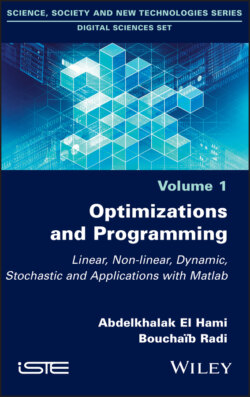Читать книгу Optimizations and Programming - Bouchaib Radi, Ghias Kharmanda, Michel Ledoux - Страница 9
Оглавление
Preface
Optimization is the domain of mathematics that studies how to minimize (or maximize) a certain objective, for example, an economic parameter or some type of energy. This is both an ancient topic, with the earliest optimization problems going back to Euclid, and a relatively new topic, with the recent development of numerical methods such as linear programming, which only truly began to flourish in the second half of the 20th century. As an illustration, imagine the problem of searching for a path that joins two points on a map in the shortest time. Some parameters of the problem might be uncertain; for example, we might encounter a traffic jam on the road. Optimization seeks to find the best compromise between the various possible risks.
In the presence of uncertainty, the optimizer (or decider) will often take advantage of information about the system that becomes available dynamically, i.e. gradually over time. For example, we will gradually discover which roads are most susceptible to traffic jams over time, as we try them out. The difficulty of an optimization problem is closely linked to the amount of information needed to make an optimal decision. A problem is said to be large if this quantity of information is too big for classical solving techniques to be applied by brute force.
This book is divided into two parts: programming (Part 1) and optimization (Part 2). In the programming part, we present a collection of tools for operations research, including linear programming, integer programming, binary programming, dynamic programming and stochastic programming. Operations research first arose in the United Kingdom during the Second World War, when scientific methods were used to study various aspects of military operations. Since then, it has become a key element of decision-making processes in various commercial, industrial and governmental contexts, offering a systematic way to apprehend the ever increasing complexity of the management problems faced by both the private and public sectors.
Following its success in military matters during the Second World War, operations research was applied to operational problems in the industry and private sector for many years. In the last decade or so, its applications have been extended to other domains, such as economics, finance, marketing and corporate planning. More recently, operations research has been used to manage healthcare and education systems, solve environmental problems and in other areas of public interest. Its principal users are manufacturing, distribution and retail companies in the mining, energy, transportation and construction sectors, as well as service companies such as banks, and various government bodies. Noteworthy examples of recent applications of operations research include logistical studies, railway safety, packaging design, strategic workforce planning, aerial transportation, forestry operations, nuclear fuel optimization, production planning, and so on.
The optimization part of this book is divided into three chapters: combinatorial optimization, nonlinear optimization without constraints and nonlinear optimization with constraints. It is entirely dedicated to numerical optimization algorithms, their theoretical foundations and convergence properties, their implementation and application, and other practical aspects. The objective is to familiarize readers with these numerical algorithms in order to understand how they behave in practice, how to properly take advantage of Matlab as a tool, how to design and adequately implement such algorithms and how to correctly diagnose any difficulties that might arise.
Each chapter starts with a few reminders of key results, but readers should not hesitate to consult the references listed at the end of the book. This book is organized according to a strictly linear approach. As a general rule, the concepts are illustrated with examples. Each chapter ends with an example in Matlab.
Acknowledgments
We would like to thank everyone who contributed, directly or indirectly, to the writing of this book and especially, the engineering and PhD students of INSA Rouen whom we have had the pleasure of supervising over the past few years.
Bouchaib RADI
Abdelkhalak EL HAMI
November 2020
